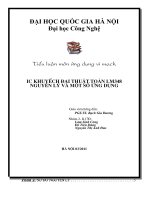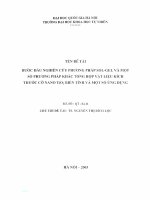Stolz Cesaro Lý thuyết và một số ứng dụng
Bạn đang xem bản rút gọn của tài liệu. Xem và tải ngay bản đầy đủ của tài liệu tại đây (28.31 KB, 4 trang )
The purpose of this note is to show how
obtain limit or equivalent of sequence with Theorem Stolz-Cesaro
by Moubinool OMARJEE
Let me remind the main tool in this note
___________________________________________________________
Theorem of Stolz-Cesaro: a n n≥0 , b n n≥0 sequences of reals numbers.
Assume b n n≥0 is strictly increasing , unbounded and the following
limit exist
lim a n+1 − a n = L
n→+∞ b n+1 − b n
Then the
lim a n also exist and its equal to L
bn
n→+∞
____________________________________________________________
APPLICATION 1 : x n n≥1 sequence of real number with x n > 0 for any n ≥ 1
lim x n = +∞
n→+∞ n
Then
n
∑
lim 1
n→+∞
n
k=1
1 =0
xn
Proof: With S.C (Stolz-Cesaro)
n
lim 1
n→+∞
n
∑
k=1
1 = lim
n→+∞
xn
1
x n+1
= n→+∞
lim
n+1 − n
n+1 + n
n+1
= n→+∞
lim 2
=0
x n+1
x n+1
APPLICATION 2 : x n n≥1 sequence of real number given by
xn =
n
k. k!
∑ k=1
n + 1! − 1
Find the limit of x n n≥1
Proof: With S.C
lim x
n→+∞ n
= n→+∞
lim
n + 1n + 1!
n + 1n + 1!
= n→+∞
lim
=1
n + 2! − n + 1!
n + 1n + 1!
APPLICATION 3 :x n n≥1 sequence of real number with x 1 = 1
x n+1 = x 1 + x 2 +. . . +x n
Find
lim x n
n→+∞ n
Proof: All the term of x n n≥1 are strictly positive x 2n+1 = x 2n + x n
x n n≥1 is strictly increasing, if it was bounded then
lim x
n→+∞ n
exist = L
L2 = L2 + L
This gives the limit L = 0 contradiction since all x n ≥ 1. So
lim x
n→+∞ n
= +∞
x 2n+1
= 1 + x1n → 1
x 2n
lim x n+1 = 1
n→+∞ x n
With S.C theorem
x n = lim x n+1 − x n = lim x 2n+1 − x 2n
lim
n→+∞ n
n→+∞ n + 1 − n
n→+∞ x n+1 + x n
= n→+∞
lim x x n+ x = n→+∞
lim x n+11
= 1 = 1
n+1
n
1+1
2
+
1
xn
APPLICATION 4 :Find
lim
n→+∞
lnn! − n lnn
n
Proof: With S.C.
lnn! − n lnn
lnn + 1 − n + 1 lnn + 1 + n lnn
lim
= n→+∞
lim
n
n→+∞
n + 1 − n
= n→+∞
lim −n lnn + 1 + n lnn = n→+∞
lim −
ln1 +
1
n
1
n
= −1
APPLICATION 5: Find
n
Ene n
∑ k=1
1
lim
n2
n→+∞
Proof: With S.C
n
Eke k
∑ k=1
1
lim
n→+∞
n2
1
Ene n
n
= n→+∞
lim 2
= n→+∞
lim
= 1
2
2n + 1
n − n − 1 2
APPLICATION 6: x n n≥1 sequence of real number with
n
lim x
x2 = 1
n→+∞ n ∑ k
k=1
Prove that
lim 3 3n x n = 1
n→+∞
Proof: S n = ∑ k=1 x 2k , x n S n tend to 1. The sequence S n is strictly increasing
n
if S n converge to L , then x n → L1 > 0 and we will have S n = ∑ k=1 x 2k → +∞
contradiction. We have
n
lim S n = +∞ and n→+∞
lim x n = 0
n→+∞
We also have x n S n−1 → 1 when n → +∞ and
S 3n − S 3n−1 = x 2n S 2n + S n S n−1 + S 2n−1 → 3 when n → +∞
With S.C.
S 3 − S 3n−1
S3
lim n
=3
lim nn = n→+∞
n − n − 1
n→+∞
We deduce that
3
3
3n
→1
Sn
3n x n =
3
3n
x S →1
Sn n n
APPLICATION 7: x n n≥1 sequence of reals numbers with 0 < x 1 < 1 and
x n+1 = x n − x 2n for any n ≥ 1. Prove that
lim nx n = 1
n→+∞
Proof: The sequence x n n≥1 is decreasing and bounded
lim x
n→+∞ n
= L exist
L = L − L2
So L = 0
Consider y n =
1
xn
with S.C.
y
y − yn
x n+1
lim n = n→+∞
lim n+1
= n→+∞
lim x nx n−x n+1
n→+∞ n
n + 1 − n
x 2n
1
= n→+∞
lim
= n→+∞
lim
=1
1 − xn
x n x n − x 2n
APPLICATION 8: x n n≥1 sequence of reals numbers with x 1 = 1
x n+1 =
x 2n +2
n+1
for any n ≥ 1. Find
n
xk
∑ k=1
lim
1
n→+∞ ∑ n
k=1 k
Proof: By induction 0 < x n ≤ 2 for any n ≥ 2
2
0 < x n+1 ≤ 2 + 2 → 0 when n → +∞
n+1
With S.C.
n
xk
∑ k=1
x n = lim n x 2n−1 + 2 = 2
lim
=
lim
1
n
n→+∞ ∑ n
n→+∞ 1
n→+∞
n
k=1 k
APPLICATION 9: x n n≥1 sequence of reals numbers such that
lim x n+1n− x n = L > 0
n→+∞
Prove that
lim
n→+∞
n+1
x n+1
− xn
n n!
n + 1!
= eL
2
Proof: Since x n+1 − x n ∼ nL the equivalence of partial sum for divergence
n−1
n−1
gives ∑ k=1 x k+1 − x k ∼ L ∑ k=1 k this gives xnn ∼ nL
2
With S.C.
x n+1
− nx n
n+1 n+1!
n!
x n+1
lim
− xn
= n→+∞
lim
n→+∞
n n!
n + 1 − n
n+1 n + 1!
= n→+∞
lim
x n = eL
2
n n n!
Since
n
1
n!
=
e
n
−
e lnn+ln2π
2
n2
+O
1
n3









